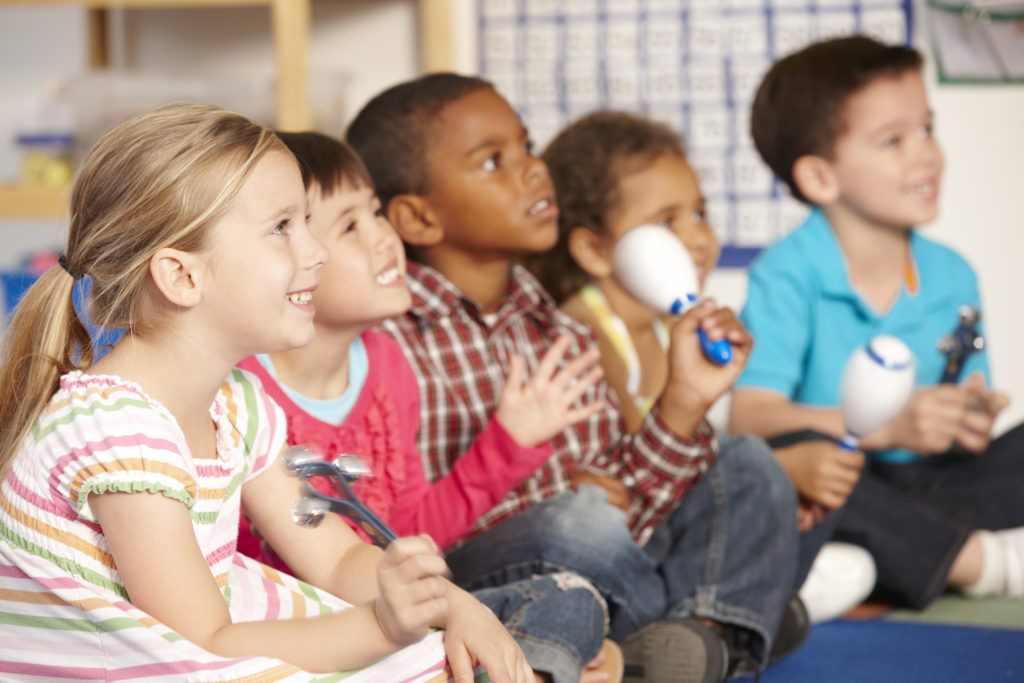A Music Educator’s Top Tips for Interdisciplinary Instruction in the Classroom

Group Of Elementary Age Schoolchildren In Music Class With Instruments
My first encounter with interdisciplinary instruction did not happen voluntarily. During my first year of teaching music, I was responsible for implementing the Drop Everything And Read program during my class time. My lack of expertise as a reading teacher made me feel unqualified to guide students through the program, and I struggled to think of ways to help them read. I knew it would not be the last time that I would be asked to support language arts instruction in my music classroom, as it is not uncommon for teachers from all subject areas to support reading and writing — both essential components of functional literacy.
Following that teaching experience, I focused on devoting my research agenda to the integration of music and language arts. What I learned since that day is that integrating music and language arts literacies creates an immersive experience for students. Through interdisciplinary instruction — which involves integrating two or more subject areas or disciplines — students use the various cognitive and experiential viewpoints of each discipline to learn content knowledge and academic concepts. I also realized that just as much as I was using music to support language arts literacy, language arts literacy helped my students further understand music. This inspired me to pursue interdisciplinary instruction, and I learned the following tips along the way.
- Expand the definition of literacy
The first thing that helped me get over my hesitancy about the topic was to expand my definition of literacy. Understanding multiple forms of literacy provided the flexibility to shift from teaching music in isolation to exploring ways to encompass and create bridges to other disciplines. This perspective allowed me to focus more on the benefits of integrating other subjects that can help students gain a deeper understanding of music. - Educate yourself about interdisciplinary instruction
After learning about various ways integration can occur, I became overwhelmed with how to make it work. I read more about integration approaches to help determine what approach was applicable for me. Choosing an approach that best works for you and your students early in implementation can help address potential challenges and complications. With an approach in place, you can then focus on communicating and collaborating with your colleagues.
- Collaborate with discipline specialists
This tip is essential to implement effective and meaningful interdisciplinary instruction. It can be a daunting task to become knowledgeable in all things related to other academic subjects. Communicating with discipline specialists can help to identify commonalities among subjects and collaborating can produce lesson ideas that ensure the integrity of all subjects is maintained. I found it most helpful to talk with colleagues to identify themes, concepts, or skills — like form, conflict/resolution, and analysis — that are evident in or used across subjects that I could teach through the lens of music. - Identify disciplinary connections that occur naturally
Collaborate with subject experts to determine shared themes, concepts and common skills. You can teach through the commonalities and make those overlapping points explicit for your students. For example, when teaching a musical tone poem, students can explore the piece through visual, media, cultural and social literacy through the common concept of narratives. Teachers can present these connections in new and exciting ways, strengthening students’ understanding of how multiple literacies fit together. - Use accessible resources
It is not necessary to reinvent the wheel, as there are existing resources that can help you begin effective interdisciplinary instruction. To narrow down your search for resources, you may find it useful to look for those that offer pre-designed lesson plans or professional development opportunities. Several resources are included below to help get you started.
I hope you find these tips helpful for inspiring you to begin or continue to implement interdisciplinary teaching. Lessons designed to activate multiliteracies create an enchanting and multidimensional experience that offers students multiple access points for acquiring new knowledge. Interdisciplinary instruction also allows multiliteracies to flourish and impels students to apply their lived experiences to learning.
Resources Related to Interdisciplinary Teaching:
- The Kennedy Center – National Professional Development Resources
- The Music and Literacy Connection, Second Edition (Book and Digital Book Options)
- National Science Teaching Association: Interdisciplinary Resources
- Smithsonian Folkways
- Teaching Elementary Music: Integrative Strategies Between Music and Other Subjects. (Book and Digital Book Options)
- TeachRock
This post is part of AEP’s Continuing the Arts and Literacies Conversations blog post series. These posts expand on key ideas and topics from our Arts and Literacies Thinkers Meeting Series and from the resulting interactive resource. Through sharing their personal reflections and work experiences, guest authors explore a range of topics that span disciplines, age levels and education environments. You can read the first post in the series here.



